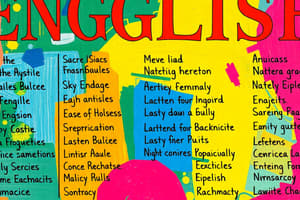Podcast
Questions and Answers
Which part of speech describes nouns?
Which part of speech describes nouns?
- Adverbs
- Adjectives (correct)
- Verbs
- Conjunctions
What is the primary sentence structure in English?
What is the primary sentence structure in English?
- Subject-Object-Verb (SOV)
- Subject-Verb-Object (SVO) (correct)
- Verb-Subject-Object (VSO)
- Object-Subject-Verb (OSV)
What is a common purpose of using transition words in writing?
What is a common purpose of using transition words in writing?
- To introduce unrelated ideas
- To connect ideas and ensure logical flow (correct)
- To add random adjectives to sentences
- To replace punctuation marks
Which of the following is an example of a synonym?
Which of the following is an example of a synonym?
Which sentence uses the future simple tense correctly?
Which sentence uses the future simple tense correctly?
What is the primary function of commas in sentences?
What is the primary function of commas in sentences?
What is essential when performing editing and revision of a written piece?
What is essential when performing editing and revision of a written piece?
What is thematic vocabulary primarily focused on?
What is thematic vocabulary primarily focused on?
Flashcards are hidden until you start studying
Study Notes
Grammar
-
Parts of Speech:
- Nouns: Name people, places, things (e.g., dog, city)
- Verbs: Indicate actions or states (e.g., run, is)
- Adjectives: Describe nouns (e.g., beautiful, quick)
- Adverbs: Modify verbs, adjectives, or other adverbs (e.g., quickly, very)
-
Tenses:
- Present Simple: Routine actions (e.g., I eat)
- Past Simple: Completed actions (e.g., I ate)
- Future Simple: Upcoming actions (e.g., I will eat)
-
Sentence Structure:
- Subject-Verb-Object (SVO) at the core (e.g., She (subject) reads (verb) a book (object)).
- The importance of clauses (independent vs. dependent).
-
Punctuation:
- Periods: End declarative sentences.
- Commas: Separate items in a list or clauses.
- Quotation Marks: Indicate direct speech or titles of short works.
Vocabulary Development
-
Word Families:
- Base words and their derivatives (e.g., teach, teacher, teaching).
-
Synonyms/Antonyms:
- Building richness by learning words with similar meanings (synonyms) and opposite meanings (antonyms).
-
Context Clues:
- Use surrounding text to infer meanings of unknown words.
-
Regular Practice:
- Reading diverse materials (books, articles).
- Using vocabulary lists and flashcards for memorization.
-
Thematic Vocabulary:
- Learning words organized by themes or topics (e.g., travel, food).
Writing Techniques
-
Structure:
- Introduction: Present main idea and purpose.
- Body: Develop arguments or narratives with clear paragraphs.
- Conclusion: Summarize key points and provide closure.
-
Coherence and Cohesion:
- Use transition words (e.g., however, furthermore) to connect ideas.
- Ensure logical flow within and between paragraphs.
-
Editing and Revision:
- Review for grammar and punctuation errors.
- Check clarity and readability; consider audience engagement.
-
Style and Voice:
- Match writing style to purpose (formal for academic, informal for personal).
- Develop a unique voice that reflects personality and perspective.
-
Feedback:
- Seek constructive criticism to refine writing skills and approach.
Parts of Speech
- Nouns, verbs, adjectives, and adverbs are the building blocks of sentences.
- Nouns name people, places, or things.
- Verbs describe actions or states of being.
- Adjectives modify nouns, providing descriptive details.
- Adverbs modify verbs, adjectives, or other adverbs, offering further information about how, when, where, or to what extent an action is performed.
Tenses
- Tenses indicate when an action takes place.
- Present Simple tense describes routine or habitual actions.
- Past Simple tense describes completed actions.
- Future Simple tense describes actions planned to occur in the future.
Sentence Structure
- The basic sentence structure is Subject-Verb-Object (SVO).
- Sentences can be complex with dependent and independent clauses.
- Clauses are groups of words containing a subject and a verb.
- An independent clause can stand alone as a complete sentence, while a dependent clause needs an independent clause to make complete sense.
Punctuation
- Periods mark the end of declarative sentences.
- Commas separate items in a list or clauses, improving readability.
- Quotation marks enclose direct speech or titles of short works.
Word Families
- Word families expand vocabulary by understanding base words and their derived forms.
- For instance, "teach" is the base word, and "teacher" and "teaching" are derivatives.
Synonyms and Antonyms
- Synonyms are words with similar meanings.
- Antonyms are words with opposite meanings.
- Learning synonyms and antonyms enriches vocabulary and allows expressing ideas in diverse ways.
Context Clues
- Use surrounding text to infer the meaning of unknown words.
- Clues can include definitions, examples, synonyms, or antonyms.
Regular Practice
- Regular reading of diverse materials (books, articles) improves vocabulary.
- Using vocabulary lists and flashcards helps memorization.
Thematic Vocabulary
- Learning vocabulary related to specific themes or topics enhances understanding of the subject.
- For example, learning travel vocabulary helps understand travel-related texts.
Writing Structure
- A well-structured essay consists of an introduction, body, and conclusion.
- The introduction presents the main idea and purpose of writing.
- The body develops arguments or narratives with clear paragraphs.
- The conclusion summarizes key points and offers a sense of closure.
Coherence and Cohesion
- Transition words connect ideas smoothly, creating coherence and flow.
- Ensure logical flow within and between paragraphs.
Editing and Revision
- Review for grammar and punctuation errors.
- Aim for clarity and readability.
- Consider audience engagement and their understanding.
Style and Voice
- Adjust writing style to the purpose and audience.
- Formal style is appropriate for academic writing, while informal style is suitable for personal writing.
- Develop a unique voice by reflecting personality and perspective in writing.
Feedback
- Seek constructive criticism from others to improve writing skills and refine the approach.
- Feedback helps identify areas for improvement and enhances writing quality.
Studying That Suits You
Use AI to generate personalized quizzes and flashcards to suit your learning preferences.




